
Standby Generators: Installation Timeline and Planning
Installing a standby generator involves a careful timeline that can span from a few days…
Standby generators are essential systems that provide reliable backup power during electrical outages, ensuring that critical appliances and systems remain operational. These generators automatically detect power loss and activate within seconds, offering convenience and peace of mind for homeowners. With various fuel options and a range of features from leading brands, standby generators enhance safety and can even increase property value.

Installing a standby generator involves a careful timeline that can span from a few days to several weeks, influenced by factors such as site preparation and local permitting. Effective planning is essential, requiring a site assessment, generator sizing, and consideration of electrical and plumbing needs to ensure compliance with local regulations and safety standards. What…
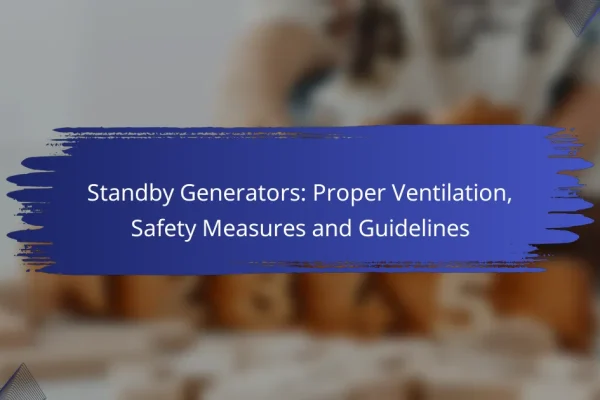
Standby generators are essential for providing reliable power during outages, but ensuring their safe operation requires careful attention to ventilation and safety measures. Proper airflow is vital to prevent overheating and mitigate the risk of harmful gas buildup. Additionally, implementing safety protocols, such as carbon monoxide detection and maintaining safe distances from structures, is crucial…
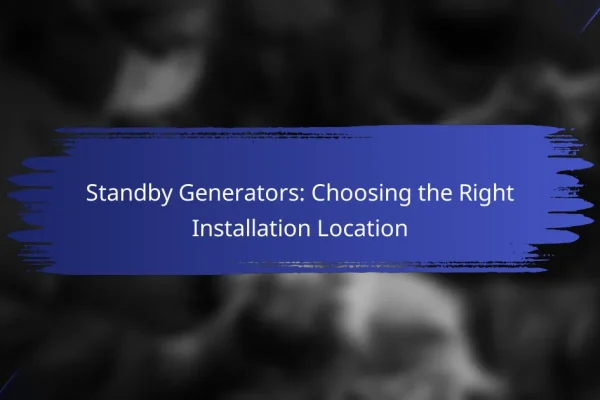
Choosing the right installation location for a standby generator is essential for ensuring safety, efficiency, and accessibility. Factors such as proximity to the utility meter, stable foundations, and proper ventilation play a significant role in the effectiveness of the generator. Additionally, it’s important to consider local regulations, including zoning laws and noise ordinances, which can…

When it comes to ensuring a reliable power supply, choosing between standby generators and portable generators can be crucial. Standby generators provide automatic power restoration and are suited for homes and businesses needing consistent electricity, while portable generators offer affordability and mobility for temporary power needs. Understanding the specific advantages of each type can help…
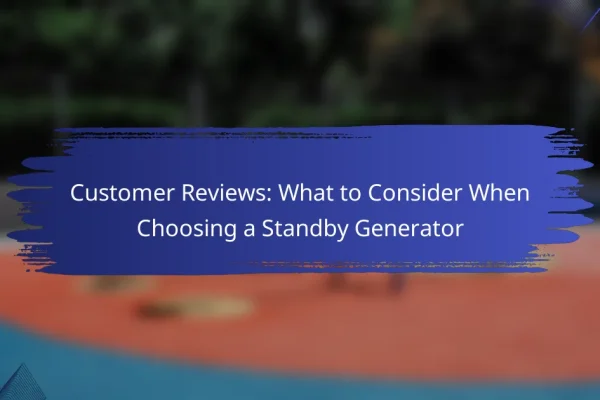
Choosing the right standby generator involves careful consideration of your power requirements, fuel options, and installation needs. Customer reviews play a crucial role in this decision-making process, offering valuable insights into the performance and reliability of various models. By examining feedback from other users, you can better assess which generator will best meet your expectations…

Home standby generators are vital for ensuring uninterrupted power during outages, but they require regular maintenance to function optimally. Essential maintenance tips include routine oil changes, battery checks, and air filter replacements, which help prolong the generator’s lifespan and reliability. By adhering to a consistent maintenance schedule, you can ensure your generator is always ready…
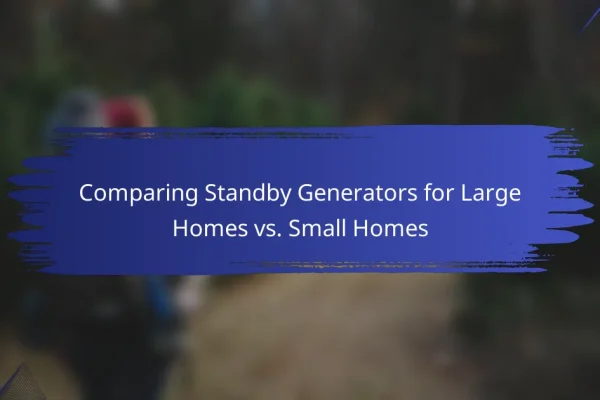
When comparing standby generators for large and small homes, it’s essential to recognize the differences in power requirements and installation complexities. Large homes demand generators with higher power outputs to support multiple appliances, while small homes typically require units ranging from 2,000 to 5,000 watts for essential needs. By understanding these distinctions, homeowners can make…

Standby generators are an essential investment for homeowners seeking reliable backup power during outages, and there are several budget-friendly options available for under $5000. These generators automatically detect power loss and start up within seconds, ensuring your home remains powered without any manual effort. When choosing the right model, it’s important to consider factors such…

When it comes to maintaining standby generators, homeowners face the choice between DIY maintenance and professional service. DIY maintenance can be cost-effective and allows for greater flexibility, but it requires a solid understanding of the equipment. On the other hand, professional services provide expert knowledge and thorough inspections, ensuring optimal performance and compliance with warranty…
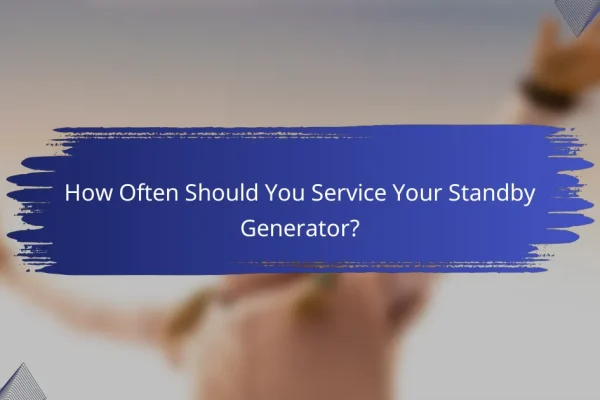
To ensure your standby generator operates reliably when needed, it is essential to service it every 6 to 12 months. Regular maintenance not only enhances performance but also helps prevent unexpected failures, ultimately extending the lifespan of your unit. By being proactive, you can identify potential issues early and keep your generator running efficiently. How…
Standby generators provide reliable backup power during outages, ensuring essential systems remain operational. Their benefits include continuous power supply, protection against outages, increased property value, enhanced safety, and convenience for homeowners.
Standby generators automatically activate when the main power supply fails, providing uninterrupted electricity. This ensures that critical appliances, such as refrigerators and medical equipment, continue to function without disruption.
Most standby generators can provide power for extended periods, depending on fuel availability. Homeowners should consider the generator's capacity to ensure it meets their specific power needs during outages.
With a standby generator, homes are safeguarded against the inconveniences of power outages. This is especially crucial in areas prone to severe weather or unreliable grid systems.
Investing in a standby generator can prevent potential losses from spoiled food, damaged electronics, and disrupted daily routines, providing peace of mind during unpredictable situations.
Installing a standby generator can enhance a property's market value. Many homebuyers view backup power as a desirable feature, particularly in regions with frequent power interruptions.
Real estate agents often highlight the presence of a standby generator as a selling point, making homes more attractive to potential buyers and potentially leading to higher sale prices.
Standby generators contribute to safety by maintaining power for security systems, lighting, and emergency devices during outages. This ensures that homes remain secure and well-lit, deterring potential intruders.
Additionally, having a reliable power source can support heating systems during winter outages, preventing dangerous situations related to extreme cold.
Standby generators offer convenience by eliminating the need for manual intervention during power failures. They start automatically, allowing homeowners to continue their activities without interruption.
This reliability provides peace of mind, knowing that essential services will remain operational, and families can stay comfortable and safe regardless of external conditions.
Standby generators automatically provide backup power during electrical outages by detecting power loss and activating within seconds. They are connected to the home’s electrical system and can run on various fuel sources, ensuring that essential appliances remain operational during disruptions.
Standby generators are equipped with an automatic transfer switch (ATS) that monitors the electrical supply. When an outage is detected, the ATS signals the generator to start, typically within 10 seconds, allowing for a seamless transition to backup power.
This quick activation minimizes disruption, ensuring that critical systems like heating, cooling, and refrigeration continue to function without interruption. Regular testing and maintenance of the ATS are essential to ensure reliability during an actual outage.
Standby generators connect directly to a home's electrical panel, allowing them to power selected circuits or the entire home, depending on the generator's capacity. This connection is usually established during installation by a licensed electrician to ensure compliance with local codes.
Homeowners can choose to power essential circuits, such as those for refrigerators and medical equipment, or opt for whole-house coverage. Understanding the generator's capacity and the home's power needs is crucial for effective operation.
Standby generators can operate on various fuel sources, including natural gas, propane, and diesel. Natural gas is often preferred for its convenience and lower emissions, while propane offers portability and can be stored indefinitely.
Fuel consumption varies based on the generator's size and load. For instance, a typical standby generator may consume between 0.5 to 1.5 gallons of fuel per hour during operation. It's important to assess fuel availability and storage options when selecting a generator to ensure continuous operation during extended outages.
The best standby generator brands are known for reliability, performance, and customer support. Key players in the market include Generac, Briggs & Stratton, Honda, and Kohler, each offering unique features and benefits tailored to different needs.
Generac is a leading brand in the standby generator market, recognized for its extensive range of models suitable for residential and commercial use. Their generators typically feature automatic transfer switches, allowing for seamless power restoration within seconds of an outage.
When considering a Generac generator, look for models with varying power outputs, generally ranging from 7 kW to over 22 kW, depending on your energy needs. Generac's mobile link technology also enables remote monitoring through a smartphone app, enhancing convenience.
Briggs & Stratton offers a solid lineup of standby generators that are known for their durability and ease of use. Their models often come equipped with features like a quiet operation mode and a user-friendly control panel.
These generators typically range from 8 kW to 20 kW, making them suitable for various home sizes. Additionally, Briggs & Stratton provides a comprehensive warranty, which can be a significant factor for buyers looking for long-term reliability.
Honda is well-regarded for its portable generators, but it also offers standby options that are compact and efficient. Honda generators are known for their fuel efficiency and low noise levels, making them ideal for residential areas.
Models generally range from 5 kW to 15 kW, providing adequate power for essential appliances. Honda's reputation for quality and customer service adds to its appeal, especially for those seeking dependable performance.
Kohler generators are recognized for their robust construction and advanced technology, making them a popular choice for both homes and businesses. Their standby generators often feature a powerful engine and a sleek design that fits well in various settings.
Power outputs typically range from 8 kW to 20 kW, with options for customization based on specific needs. Kohler also emphasizes ease of installation and maintenance, which can save time and costs in the long run.
Choosing a standby generator involves assessing your power needs, evaluating fuel types, and considering installation requirements. Each of these factors plays a crucial role in ensuring you select a generator that meets your specific energy demands and fits your home or business setup.
Start by determining the total wattage of the appliances and systems you want to power during an outage. Calculate the starting and running watts for each device, as some appliances require more power to start than to run. A common rule of thumb is to add up the wattage and then choose a generator that offers at least 20-30% more capacity to handle surges.
For example, if your essential appliances total 5,000 watts, look for a generator with a capacity of around 6,000-7,000 watts. This buffer ensures reliable performance without overloading the generator.
Standby generators typically run on natural gas, propane, or diesel. Natural gas is often preferred for its convenience and lower cost, especially in areas with existing gas lines. Propane is a good alternative if natural gas is unavailable, while diesel generators are known for their durability but can be more expensive to operate.
Consider local fuel availability and prices when making your choice. Additionally, think about the generator's fuel consumption rate, as this will impact your overall operating costs during extended outages.
Installation of a standby generator should comply with local building codes and regulations. It's essential to hire a licensed electrician or contractor to ensure proper setup, including electrical connections and ventilation. Generators should be placed at least five feet away from windows and doors to prevent exhaust fumes from entering your home.
Additionally, consider whether you need a transfer switch to safely connect the generator to your home’s electrical system. This switch allows for seamless power transfer and is often required by code for safety reasons.
The installation costs for standby generators can vary significantly based on factors such as the generator's size, type, and installation complexity. Generally, homeowners can expect to pay anywhere from a few thousand to over ten thousand USD for a complete installation.
Several factors influence the installation costs of standby generators. The generator's capacity, measured in kilowatts (kW), directly impacts the price; larger units capable of powering more appliances will typically cost more. Additionally, the complexity of the installation site, including the need for electrical upgrades or permits, can add to the overall expense.
On average, homeowners may spend between 3,000 and 7,000 USD for a basic standby generator installation. This estimate usually includes the generator itself, transfer switch, and labor costs. For more advanced systems or larger capacities, costs can rise to 10,000 USD or more, especially if extensive electrical work is required.
When planning for installation, consider local regulations and permitting requirements, which can affect both cost and timeline. It's advisable to obtain multiple quotes from licensed contractors to ensure competitive pricing. Additionally, factor in ongoing maintenance costs, which can range from a few hundred to over a thousand USD annually, depending on the generator's usage and service needs.